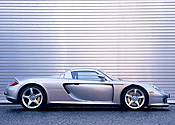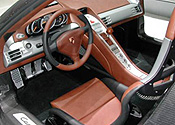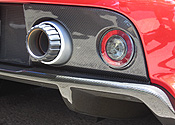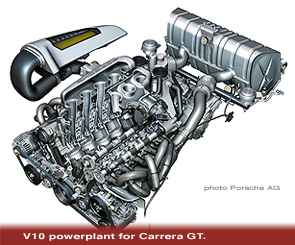



Porsche 980 (Carrera GT)
The
With its V10 engine providing more than 600 horsepower and with an array
of cutting edge technologies including a ceramic composite clutch and
brakes beneath its carbon-reinforced body, the Porsche Carrera GT uses
the undiluted qualities of a genuine racecar to provide an unprecedented
driving experience on the road. It will never be raced by Porsche
The Porsche Carrera GT, which was introduced as a 2004 model, is a low,
sleek, lightweight roadster that is as beautiful to the engineer as it
is to the eye. Foul weather protection is also available in the form of
two removable panels that can be stored in the front trunk. Among
the car’s unique features are its 5.7-liter, 605-horsepower V10
engine, its monocoque chassis with Porsche-patented engine and transmission
mounts made of carbon-reinforced plastic and the first use of a ceramic
composite clutch in a production car. The Carrera GT’s aerodynamic
and race-bred suspension package provides safe and stable travel at speeds
of up to 205 mph (330 km/h). The Carrera GT features the extensive use
of lightweight materials, such as magnesium for the car’s substantial
wheels and the frames of its special sport seats.
The result of such artistic and athletic equipment is a car that accelerates
from a standing start to 62 mph (100 km/h) in only 3.9 seconds, reaches
100 mph (160 km/h) in less than seven seconds, 125 mph (200 km/h) in less
than 10 seconds, and can achieve a top test-track speed of 205 mph (330
km/h).
 Porsche’s
development center in Weissach, Germany, built a 5.5-liter, normally aspirated
V10 engine for racing, and that engine’s bores have been enlarged
to displace 5.7 liters in the Carrera GT. Maximum output is rated at 605
horsepower at 8,000 rpm, with peak torque of 435 lb-ft. The engine has
a very low center of gravity, a 68-degree V angle and four valves-per-cylinder
heads. The engine block serves as a load-bearing part of the chassis structure,
yet is so strong that there is no distortion to the cylinder bores. Using
dry-sump lubrication reduces the number of engine components and seals
and also helps optimize weight and reliability. The engine has a closed-deck
configuration, a principle carried over from motorsports. This closeddesk
architecture enables the cylinders to be cooled by internal water chambers
that directly surround the cylinders. Three front-mounted radiators and
cross flow cooling ensure optimum heat transfer even under high engine
loads. The engine weighs only 472 pounds (214 kg). The block, crankshaft
and camshafts are all made of light alloys. The crankshaft is designed
to operate at speeds of up to 8,400 rpm and is both forged and designed
for minimum mass inertia and thus offers maximum torsional stiffness.
Porsche’s
development center in Weissach, Germany, built a 5.5-liter, normally aspirated
V10 engine for racing, and that engine’s bores have been enlarged
to displace 5.7 liters in the Carrera GT. Maximum output is rated at 605
horsepower at 8,000 rpm, with peak torque of 435 lb-ft. The engine has
a very low center of gravity, a 68-degree V angle and four valves-per-cylinder
heads. The engine block serves as a load-bearing part of the chassis structure,
yet is so strong that there is no distortion to the cylinder bores. Using
dry-sump lubrication reduces the number of engine components and seals
and also helps optimize weight and reliability. The engine has a closed-deck
configuration, a principle carried over from motorsports. This closeddesk
architecture enables the cylinders to be cooled by internal water chambers
that directly surround the cylinders. Three front-mounted radiators and
cross flow cooling ensure optimum heat transfer even under high engine
loads. The engine weighs only 472 pounds (214 kg). The block, crankshaft
and camshafts are all made of light alloys. The crankshaft is designed
to operate at speeds of up to 8,400 rpm and is both forged and designed
for minimum mass inertia and thus offers maximum torsional stiffness.
The chassis and suspension of the Porsche Carrera GT are based on the
architecture of the Porsche GT1, the car that won the 24 Hours of Le Mans
race in 1998. For example, as on the GT1, the rear track control arms
of the Carrera GT are made of aerodynamically designed steel tubes. However,
Porsche engineers did not forget the need for driving comfort on the street
when they adapted such racing-bred systems for the road-going supercar.
Like a racecar, the Carrera GT uses pushrod suspension with double-track
control arms at all four corners to give the Carrera GT its refined response
and behavior, feeding forces smoothly and efficiently into the car’s
chassis. Where many cars use MacPherson spring struts, the Carrera GT’s
spring and damper elements are operated by stainless steel pushrods and
pivot levers, which separate the guidance function from the spring action.
Even with its racing-quality performance, the Porsche Carrera GT has a
cockpit characterized by functional ambience and the extensive use of
high-tech materials. Carbon, magnesium and leather dominate interior materials,
with composite components either in their natural state or painted to
match the magnesium pieces. The car’s center console is made of
composite materials covered in galvanized magnesium and features the chassis
number imprinted on the surface. The shift lever is positioned about halfway
up the console directly next to the steering wheel. The seats are finished
in smooth leather and have manual adjustment (fore, aft and height) because
power motors would add unnecessary weight. The seats are made of a composite
carbon shell. Each seat weighs only 23.6 pounds (10.7 kg.), compared to
44.1 pounds (20 kg.) for the seats in a typical Porsche 911. Air conditioning
is optimized for weight and the car comes with a standard air filter system.
A glass screen is mounted between the supplemental safety bars to help
reduce wind buffeting. Even though the Carrera GT is a serious performance
car, it can be equipped with many comfort features, including a navigation
system and Bose audio. A battery trickle-charger is included as standard
equipment.
bo
copyright © 2003-2015 Lüfteknic | privacy | web terms | sale terms | info@lufteknic.com